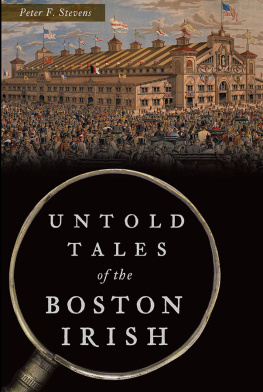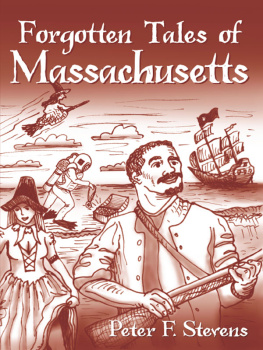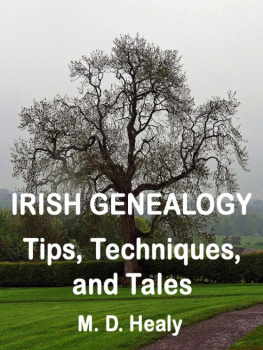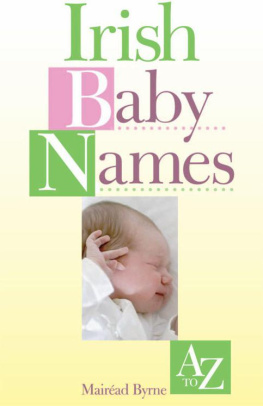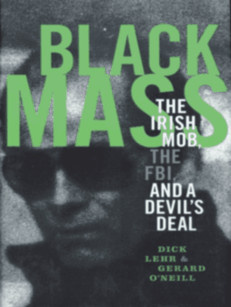HIDDEN HISTORY
OF THE
BOSTON
IRISH
HIDDEN HISTORY
OF THE
BOSTON
IRISH
Little-Known Stories from Irelands
Next Parish Over
P E T E R F. S T E V E N S

Published by The History Press
Charleston, SC 29403
www.historypress.net
Copyright 2008 by Peter Stevens
All rights reserved
Cover design by Marshall Hudson.
First published 2008, Second printing 2008, Third printing 2009,
Fourth printing 2009, Fifth printing 2010
e-book edition 2011
ISBN 978.1.61423.241.4
Library of Congress Cataloging-in-Publication Data
Stevens, Peter F.
Hidden history of the Boston Irish : little-known stories from Irelands next parish over /
Peter Stevens.
p. cm.
print edition ISBN 978-1-59629-450-9
1. Irish Americans--Massachusetts--Boston--Biography--Anecdotes. 2. Irish Americans
-Massachusetts--Boston--History--Anecdotes. 3. Boston (Mass.)--History--Anecdotes.
4. Boston (Mass.)--Biography--Anecdotes. 5. Boston (Mass.)--Ethnic relations--History-
Anecdotes. I. Title.
F73.9.I6S74 2008
974.4610049162--dc22
2008001936
Notice: The information in this book is true and complete to the best of our knowledge. It is
offered without guarantee on the part of the author or The History Press. The author and
The History Press disclaim all liability in connection with the use of this book.
All rights reserved. No part of this book may be reproduced or transmitted in any form
whatsoever without prior written permission from the publisher except in the case of brief
quotations embodied in critical articles and reviews.
CONTENTS
Your Eyes Are Full of Murder: Dominic Daley
and James Halligan
ACKNOWLEDGEMENTS
This book is a compilation and expansion of columns I have contributed to the Boston Irish Reporter over the past decade. As a writer and editor for the newspaper, I have the privilege of working with publisher Ed Forry, editor Bill Forry and editor Tom Mulvoy, three of the best in the business and three of the best friends anyone can have. All have given me free rein to write about topics that have often fallen between historys proverbial cracks. I also had the rare privilege of calling the late Mary ForryEds wife and co-publisher, a gifted writer and one of the bravest souls Ive ever encounteredmy friend.
No one can set out to write about the Boston Irish without calling upon the peerless and prolific author Professor Thomas H. OConnor, professor of history emeritus at Boston College. His work The Boston Irish: A Political History stands as a benchmark of Boston Irish history. Also at Boston College, Professor Bob ONeill has for years opened up the Burns Librarys splendid Irish collections to me on this and many other projects.
Authors Mike Quinlinfounder of Bostons Irish Heritage Trailand Dennis P. Ryan have delved into the citys vibrant and oft-controversial past to preserve the story of the Irish in these parts.
PART ONE
AND JUSTICE FOR ALL?

YOUR EYES ARE FULL
OF MURDER
Dominic Daley and James Halligan
On March 19, 1984, Governor Michael Dukakis officially proclaimed two immigrants innocent of murder. Their names were not Sacco and Vanzetti, but Daley and Halligan. For the Irishmen, justice arrived too late nearly 177 years after Daley and Halligan were hanged in Northampton, Massachusetts, for a crime they did not commit. Arrest, a sham trial and the noose sealed the fates of Daley and Halligan, whose only crimes were being Irish in the wrong place at the wrong time. That place was Massachusetts in the fall of 1805.
On November 5, 1805, a horse galloped with an empty saddle along the Boston Post Road near Wilbraham. A local man settled the mount down and began to search in the direction from which the horse had materialized. The man halted just off the road and near a bend of the Chicopee River, where a body bobbed in the cold water.
Once local authorities fished the corpse from the river, they identified it as Marcus Lyon, a youthful farmer from Connecticut. A pistol ball had torn into his ribcage, and his killer or killers had smashed his head to a pulp. As word of the savage murder spread throughout Western Massachusetts and across the New York and Connecticut borders, search parties tracked the Boston Post Road, fields and forests for suspicious men, especially strangers. The constables prowled the region for two burly men who looked like sailors and were headed toward New York, following the sighting provided by a local thirteen-year-old boy named Laertes Fuller, who claimed to have spotted the pair near the murder site.
Sometime in late 1805, a search party rode upon two menthirty-four-year-old Dominic Daley and twenty-seven-year-old James Halligannear Rye, New York. The duos brogues and rough appearance made them instantly suspicious to the constables. Daley and Halligan, however, made no kind of resistance but professed innocence and willingness to be searched. The constables answered by throwing the Irishmen in chains and hauling the prisoners to a dark cell in Northampton.
Shortly after Daley and Halligan were imprisoned, local authorities escorted young Fuller into the jail for a look at the manacled suspects. The boy proclaimed them to be the very men he had seen fleeing from the purported crime scene.
For locals, mostly Protestant, an almost palpable sense of relief greeted Fullers eyewitness identification. The fact that the alleged killers were Irish assuaged fears that one or more of the regions own native-born Protestant Americans had committed such a brutal act. As a Massachusetts jurist would later contend, locals preferred to believe that only outsiders could have killed so savagely, and in early nineteenth-century New England, Irish Catholic immigrants were the quintessential outsiders.
The authorities allowed no one except Special Prosecutor James Hooker of Springfield to visit Daley and Halligan until April 22, 1806. Only then, the day the Irishmen finally found themselves in the Northampton Courthouse and formally charged with the murder of Marcus Lyon, were the shackled suspects allowed the services of a defense counsel. Daley and Halligan immediately and vehemently entered a plea of innocence.
The court responded by allowing the prisoners all of forty-eight hours to prepare a defense with their court-appointed attorneys. The accused Irishmens lead lawyer was Francis Blake, a Worcester barrister with no experience in capital cases. Similarly, no others among the defense team had ever argued a murder trial. Historian John T. Galvin notes, The lawyers assigned had so little experience that they would not have been considered qualified to handle a capital case today.
The trial of Dominic Daley and James Halligan opened as scheduled at 9:00 a.m. on April 24, 1806, with Massachusetts Supreme Court Justices Samuel Sewall and Theodore Sedgwick on the bench. Sewall was a descendant of the Puritan judge who had dispensed justice during the Salem witch trials. In Sedgwick, the prisoners faced a jurist who in 1774 had espoused the inherent rights of all men in the Sheffield Declaration, but whose definition of all did not seem to extend to Irish Catholic immigrants.
Prosecuting the case was lawyer and politician-on-the-rise James Sullivan, no less a personage than the Massachusetts attorney general and a candidate for governor. Sullivan, his surname notwithstanding, had long espoused virulent anti-Irish and anti-Catholic dogma. In an election year, Sullivans successful prosecution of two Irish murderers could vault him to the statehouse.


